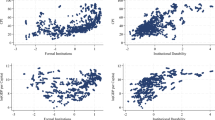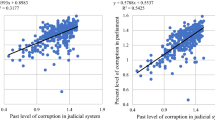Abstract
In this paper, we consider a simple model capable of explaining why some dictatorships choose to extract rents via seemingly inefficient institutions. In particular, this paper focuses on institutions associated with high levels of corruption and examines the conditions under which such institutions could serve the interests of a dictatorship. Developing such a model requires that we pose alternative institutions that dictators can choose to extract rents. Using this framework, this paper builds a model providing a theoretical basis for some stylized facts about the observed crosscountry variation in corruption levels. Specifically, the model motivates a rationale for the finding that higher levels of corruption are observed in countries characterized as having more heterogeneous populations, longer expected dictator tenure, and more severe punishment norms. The model is then estimated using international country level data.
Similar content being viewed by others
References
Ades A, Di Tella R (1999) Rents, competition, and corruption. Am Econ Rev 89(4): 982–993
Beck T, Clarke G, Groff A, Keefer P, Walsh P (2001) New tools in comparative political economy: the database of political institutions. World Bank Econ Rev 15(1): 165–176
Bergsten CF, Freeman C, Lardy N, Mitchell D (2008) China’s rise. Peterson Institute for International Economics, Washington
Besley T, McLaren J (1993) Taxes and bribery: the role of wage incentives. Econ J 103(416): 119–141
Djankov S, McLeish C, Nenova T, Shleifer A (2001) Who owns the media? World bank policy research working paper 2620. The World Bank, Washington
Fairbank JK (1964) Trade and diplomacy on the China coast. Harvard University Press, Cambridge
Fredriksson P, Svesson J (2003) Political instability, corruption and policy formation: the case of environmental policy. J Public Econ 87: 1383–1405
Fisman R, Gatti R (2002) Decentralization and corruption: evidence across countries. J Public Econ 83(3): 325–345
Gupta S, Davoodi H, Alonso-Terme R (2002) Does corruption affect income inequality and poverty?. Econ Gov 3(1): 23–45
Kaufman D, Kraay A, Mastruzzi M (2003) Governance matters III: governance indicators for 1996-2002. Policy Research Paper 3106. The World Bank, Washington
Krain M (1997) State sponsored mass murder. J Confl Resolut 41(3): 331–360
Knack S, Azfar O (2000) Are larger countries really more corrupt? Sample selection, country size and the quality of governance. Policy Research Working Paper 2470. The World Bank, Washington
Lambsdorff JG (2002) Making corrupt deals: contracting in the shadow of the law. J Econ Behav Organ 48(3): 221–241
Lambsdorff JG (2003) How corruption affects persistent capital flows. Econ Gov 4(3): 229–244
LaPorta R, Lopez-de-Silanes F, Shleifer A, Vishny R (1998) J Polit Economy 106(6): 1113–1155
Lederman D, Loayza N, Soares R (2001) Accountability and corruption: political institutions matter. The World Bank, Washington
Linz J, Stephan A (1996) Toward consolidated democracies. J Democr 7(2): 14–33
Mathewson F, Winter R (1985) The economics of franchise contracts. J Law Econ 28(3): 503–526
Mauro Paolo (1995) Corruption and growth. Q J Econ 110(3): 681–712
Pellegrini L, Gerlagh R (2008) Causes of corruption: a survey of cross-country analyses and extended results 9(4):245–263
Persson T, Roland G, Tabelinni G (1997) Separation of powers and political accountability. Q J Econ 112(4): 1163–1202
Rauch J, Evans P (2000) Bureaucratic structure and bureaucratic performance in less developed countries. J Public Econ 75(1): 49–71
Svensson J (2000) Foreign aid and rent-seeking. J Int Econ 51(2): 437–461
Treisman D (2000) The causes of corruption: a cross national study. J Public Econ 76(3): 399–457
Van Rijckeghem C, Weder B (2001) Bureaucratic corruption and the rate of temptation: do wages in the civil service affect corruption, and by how much?. J Dev Econ 65(2): 307–331
Wei SJ (2000) How taxing is corruption on international investors?. Rev Econ Stat 82: 1–11
Wintrobe R (1998) The political economy of dictatorships. Cambridge University Press, Cambridge
Wintrobe R (2001) How to understand, and deal with dictatorship: an economist’s view. Econ Gov 2: 35–58
Wright S (1936) The origins and development of the Chinese customs service. Manuscript for private circulation only, Shanghai
Wright S (1950) Hart and the Chinese customs. The Queen’s University Press, Belfast
Author information
Authors and Affiliations
Corresponding author
Rights and permissions
About this article
Cite this article
Hallagan, W. Corruption in dictatorships. Econ Gov 11, 27–49 (2010). https://doi.org/10.1007/s10101-009-0066-y
Received:
Accepted:
Published:
Issue Date:
DOI: https://doi.org/10.1007/s10101-009-0066-y




